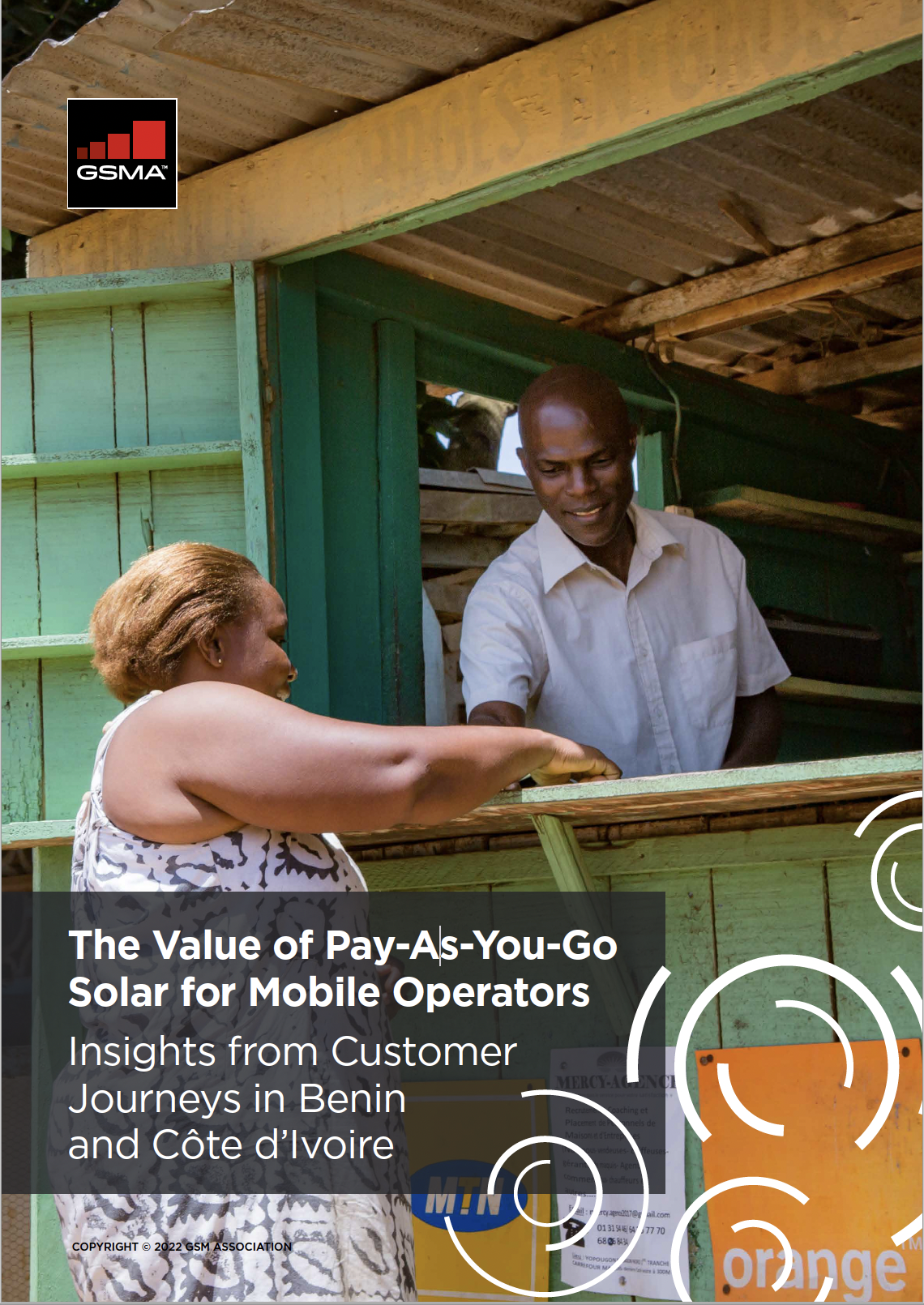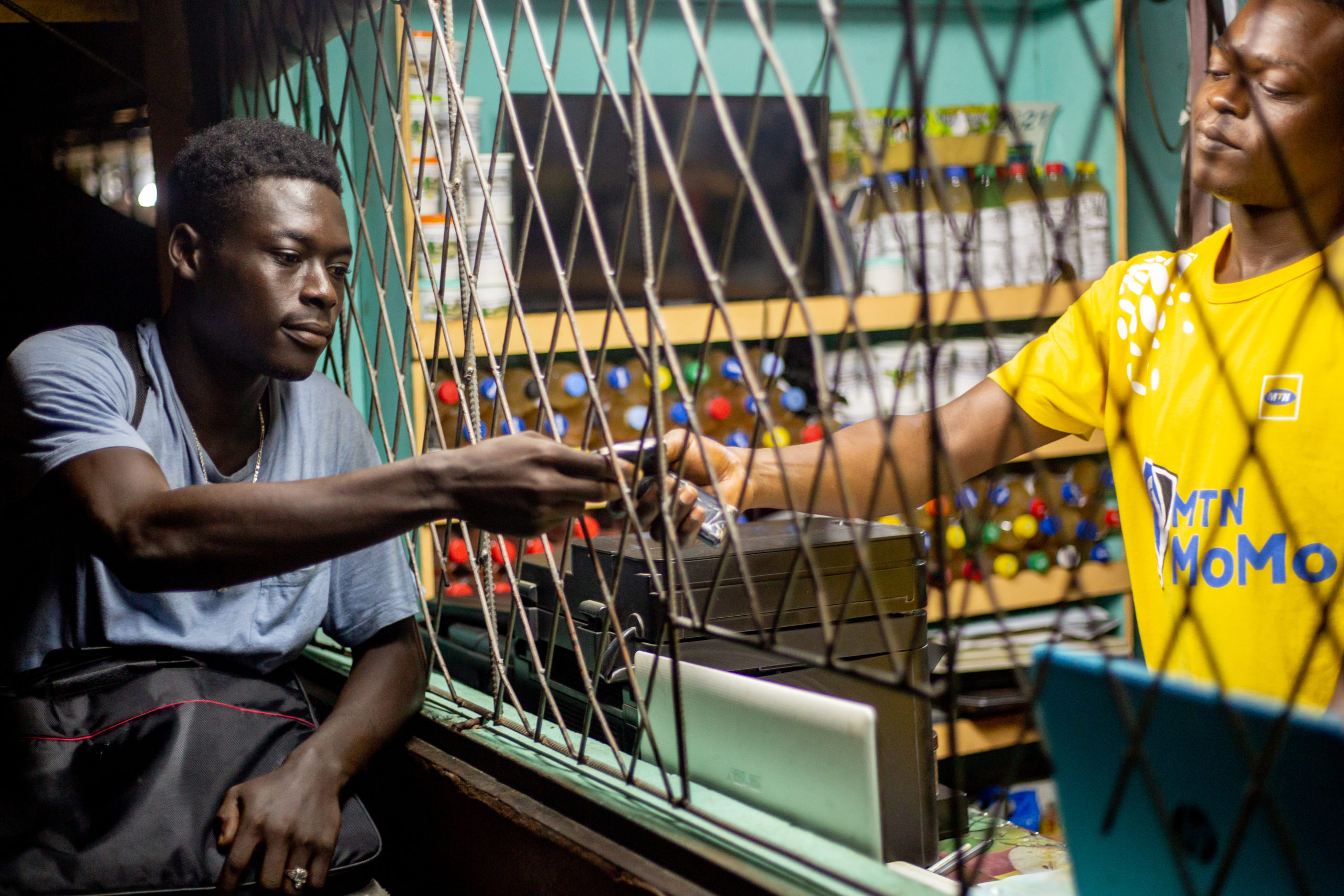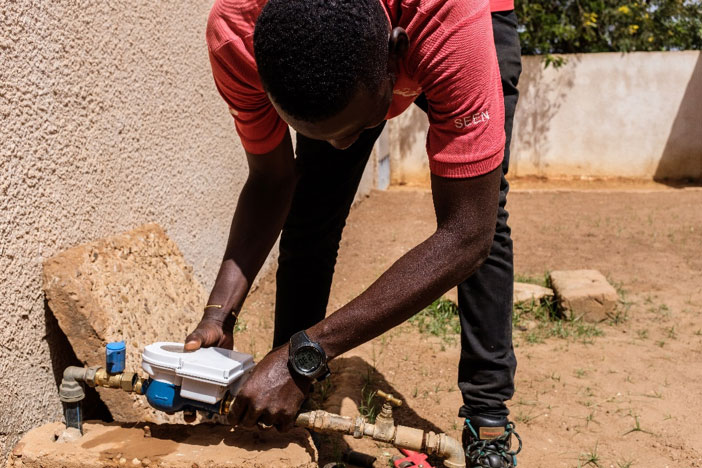What is the impact of pay-as-you-go solar on consumers?
This study explores how and why users changed their use of mobile services after adopting pay-as-you-go (PAYG) solar. It draws on an updated quantitative analysis of MNO data and in-depth qualitative interviews with end-users on their customer journeys.
Pay-as-you-go (PAYG) technologies, combined with mobile payments, have enabled a new wave of consumer asset financing for low-income customers. PAYG locking technologies, built on machine-to-machine communication, enable service providers to manage credit risk for low-income and unbanked customers. While the growth of mobile money has enabled cost-effective payment collection from remote customers. PAYG solar has emerged as one of the strongest use cases for this technology, and the sector has matured from a handful of pilots to a global industry in under a decade.
The synergies between mobile operators and PAYG solar providers have been clear from the start. Mobile operators provide the fundamental ingredients for PAYG through mobile money and connectivity. On the other side, PAYG solar boosts operator revenues from mobile money transactions and other services.
Methodology
Past GSMA research has clearly demonstrated the benefit quantitatively. Our new research, conducted in partnership with MTN in Benin and Orange in Côte d’Ivoire, examines how and why people changed their behaviour. To understand customer behaviour, three frameworks were used to examine three dimensions of behaviour change:
How did each driver change behaviour in mobile use?
The motivations of customers were examined using the Capabilities, Opportunity and Motivation Behaviour Change (COM-B) framework.
For whom is each driver changing behaviour?
This was examined by considering the characteristics of customer personas most relevant to behaviour change.
When was behaviour change triggered?
This was explored using the SHS Customer Journey Framework.
We conducted a series of 120 in-depth interviews with end users, focused on understanding the reasons behind their behaviour change. We find ten key reasons why people change their behaviour, and explore the questions of how, when, and for whom behaviour changes.
Click on a slice to view more details about that factor
Select a factor to view the detailed results
Phones on and charged more often
By far the greatest impact on increased data and voice usage is that SHS allow users to charge their phones more easily and, therefore, use their phones more often.
Prior to having a SHS, many users would have to travel to access electricity, either through friends and family or by paying to charge their phones. These barriers prevented people from using their phones more often and more extensively. Phones were more likely to remain out of power for extended periods. Other times, people would intentionally switch off their devices to preserve remaining battery life for important calls or activities later.
PAYG SHS allow people to use their phone for more hours in a day and without having to worry whether certain uses, such as data consumption, would deplete the battery too quickly. Greater availability of powered devices therefore also translates into greater use of data and voice services.
Extended Evenings
SHS users often have more leisure, social and work time later in the evenings since their homes are now powered with electricity. This extra time is often spent on activities that consume data and voice services.
With more light, households are also awake later in the evening, often engaging with family and neighbours. Likewise, for SHS users who purchased a TV, family and friends often gather late into the night to watch news, sports and entertainment programmes.
As behaviours and social norms shift due to newfound electricity, activities that rely on mobile data become more mainstream. For example, users with smartphones reported downloading music and movies.
Those who may have rarely used the internet before sign up for social media accounts and connect for the first time online with others through photos, videos and messages. Together, these changes in lifestyle organically lead to more data use for those who can afford it. In communities where PAYG SHS are present, there is a ‘snowball’ or ‘herd’ effect whereby other households also start to desire electricity, entertainment and information like their peers.
Switching operators
After purchasing an SHS, some users shift their data/voice business from one mobile operator to another. In some cases, users start engaging with a new mobile operator primarily because of their SHS.
One user in Benin who had primarily used another operator before signing up for Engie, switched to MTN because of his SHS. After trying out data bundles purchased via mobile money, he started shifting his internet use to the new network, discovering that their service was more suited to his needs.
Frequency of cash-ins
Since many users make frequent SHS payments, they are also making more mobile money deposits.
In Benin, the majority of users interviewed were depositing and immediately paying Engie multiple times per week in very small amounts. In Côte d’Ivoire, users paid less frequently – often weekly or monthly – and in larger amounts. However, in both countries, most SHS payments were closely preceded by mobile money deposits, rather than being made using money saved in mobile money accounts over time.
The difference in payment behaviour between the two markets is likely because incomes in Benin are lower and more irregular than in Côte d’Ivoire. Users there often mentioned they would pay for their SHS when they could find the money. “We used to pay 10,000 francs at once, but because times are hard we now pay 2,000 every few days,” noted one user. Another shared, “If I have money, I put a little on Fenix [Engie]. If I don’t, I don’t”. In Côte d’Ivoire, where respondents indicated having fewer financial challenges, SHS is a service that more users can pay for in larger amounts. It is also worth noting that the sample of respondents in Côte d’Ivoire was more rural and would likely have higher transaction costs due to a lower density of mobile money agents.
Agent density is a critical factor in both mobile money uptake and financial inclusion, and the findings of this research confirm that it drives behaviour with PAYG solar. According to 2019 figures from the GSMA, a mobile money agent has approximately seven times the reach of ATMs and 20 times the reach of bank branches, but it can differ substantially within and across countries. In 2019, the density of the agent network averaged 228 active mobile money agents per 100,000 adults, a three-fold increase since 2014. Meanwhile, commercial bank branches in the same markets averaged 11 per 100,000 adults, a figure that did not change substantially between 2014 and 2018.
Past research by BFA Global has highlighted the importance of payment flexibility to the central value proposition of PAYG solar, as it drives financial inclusion and access to services. In both countries, payment flexibility is an option, but where incomes are lower and payments are more frequent, certain norms appear to form around how agents explain payments to customers. In Benin, more respondents noted that agents explained that the SHS functions for a daily price – the more you pay, the more days of electricity you receive. In Côte d’Ivoire, however, it appears that pricing was framed more in terms of a monthly amount with the option to accumulate over time.
More confident in mobile money
Thanks to the onboarding they received for their SHS and the frequency with which customers pay for their SHS through mobile money, they have become more confident mobile money users.
Before acquiring their SHS, many customers were nascent mobile money users, lacking the confidence to conduct transactions on their own. Many, especially in Benin, reported they did not use mobile money very often, primarily used it to receive and withdraw funds and did not have a good understanding of the wider system.
When installing SHS, agents for both Orange Energie and Engie show customers how to pay using mobile money and almost always leave behind a piece of paper with the USSD code on it. This helps customers understand and gain confidence in paying for their subscription. As they make these transactions more regularly, they often become more confident in using mobile money for other types of transactions and on their own, rather than relying on an agent for assistance.
Linked subscriptions and add-ons
When purchasing an SHS kit that includes a TV, many users add on satellite TV services that are also paid for via mobile money. Additional SHS appliances also increase transactions. An obvious reason for increased mobile money transactions among SHS users who purchase TVs is that they also subscribe to satellite TV services, often through the same agents that sell them the SHS. Canal+ and Star Times are the two leading TV providers in Côte d’Ivoire and Benin.
The impact of these linked products has been most pronounced for Orange Energie, which include a TV in all their packages. In Benin, meanwhile, many users opted for packages without TVs because they were more affordable or the lowest level entry into SHS ownership.
Mobile money transactions also increase when SHS providers offer add-ons beyond their main kits. For example, Orange Energie allows users to add fans that they pay for separately.
Higher earnings
For many SHS users, longer business/working hours are allowing them to earn and save more money, which often ends up in mobile money accounts.
This finding is in line with industry research that has found evidence of how access to electricity affects income. A 2018 GOGLA study in five African markets found that more than a third of new solar users increased their income by at least $35 per month – a figure equivalent to more than half the monthly GDP per capita of those countries.
Several users who were interviewed indicated they believe their SHS has allowed them to increase their business revenues, primarily by extending their hours at night or by avoiding lost revenue during power cuts. This is especially true for shopkeepers/traders, barbers and mobile money agents. Not only are agents earning more money, but they are also facilitating more mobile money transactions for their community members later in the evening, creating a multiplier effect. Those who are earning more often shared examples of how this money finds its way into their mobile money accounts, whether via savings in the accounts or sent to family/friends via P2P transfers.
More trust in mobile money
Prior to having a SHS, many users did not fully trust mobile money. However, after using mobile money regularly for their SHS payments, they have developed more trust in the platform. There are numerous reasons for this lack of trust. Some cited instances in the past where they felt they had lost money from their mobile money accounts. Others, especially in Côte d’Ivoire, noted there are many instances of scammers trying to take advantage of mobile money users. Others simply did not trust mobile money because they had limited experience using it.
Because SHS users are frequently depositing funds, paying their bill and seeing their transactions result in regular electricity, they now experience mobile money working as it was designed. Receiving a confirmation SMS after depositing funds into mobile money accounts and making an SHS payment plays a big role in building customer trust. Experiencing the speed and convenience of mobile money also strengthens their trust. This was most evident among users who said that when they first got their SHS, they made small daily payments to test the system. Over time, many of these users became more confident and shifted to larger weekly and monthly payments (if they could afford it).
Keeping money in the ecosystem
Whereas mobile money users may have previously withdrawn funds from their mobile money accounts, more are now leaving those balances on their phones to pay for their SHS. Keeping money in the ecosystem is vital to strengthen it. As highlighted in the GSMA State of the Industry Report on Mobile Money 2021, as of December 2020, $23 billion was circulating in the mobile money ecosystem.
Very few SHS users reported depositing more money in their mobile money accounts to save for their SHS payments. Instead, most opted for deposits followed by immediate SHS payments. However, it was observed that users may reduce the number and value of cash-outs they make to use their account balance for SHS payments. This was especially true for users who received peer-to-peer transfers from friends and family or payments from customers. Some users may be shifting more of these types of transactions onto the mobile money platforms used by SHS providers. All these actions deepen user engagement with the mobile money ecosystem.
Discovering new services
Because they must make their SHS payments via mobile money, many users have discovered new services or conveniences that prompted them to use mobile money for new types of transactions. Several interviewees shared stories of how their mobile money usage expanded organically as they engaged more with the platform. For example, some users who visited the platform frequently to deposit money for their SHS payment began adding other types of transactions, such as paying other bills or sending money to friends and family. Other users pointed to new types of transactions they either had not been familiar with or did not know were possible with mobile money.
Electricity customer journey
Device journey
Electricity customer journey
Device journey
Mobile money customer journey
Mobile data customer journey
Proximity to mobile money agents
Income
Proximity to mobile money agents
Mobile money customer journey
Mobile money customer journey
Income
Device journey
Mobile money customer journey
Proximity to mobile money agents
Electricity customer journey
Mobile money customer journey
Income
Mobile money customer journey
Those at an earlier stage of their electricity customer journey are likely to change more as home charging is introduced for the first time.
Those with more advanced devices stand to gain the most as their devices discharge more quickly than basic phones.
Those at an earlier stage of their mobile money and mobile data journeys are more likely to switch to competitor networks.
Those who are located closer to mobile money agents are able to take advantage of more frequent cash-ins.
Those with lower and more irregular incomes are more likely to take advantage of small, frequent payments.
Those who are located closer to mobile money agents are able to take advantage of more frequent cash-ins.
Those at an earlier stage of their mobile money journey stand to gain the most confidence.
Those with higher incomes have the ability to take advantage of additional subscriptions more than those with lower incomes.
Those with more advanced devices are more likely to take advantage of additional subscriptions. For example, a smartphone owner may opt for music or video streaming add-ons.
Those more advanced in their mobile money journeys are typically more likely to deposit additional earnings in their mobile wallets.
Those who live closer to mobile money agents are more likely to move additional earnings in their mobile wallets.
Those who own businesses and are at an earlier stage oftheir electricity journey stand to gain the most.
Those at an earlier stage of their mobile money journey stand to gain the most in terms of trust.
Those more advanced in their mobile money journeys are more likely to keep money from other transactions in their mobile wallets for SHS.
Those with higher incomes are more able to save money in their mobile wallets rather than withdraw for other expenses.
Those at an earlier stage of their mobile money journey are more likely to discover new services on mobile money
Use cases: New electricity from the SHS allows users to charge and keep their phones on more often.
Impacts: Secondary impacts from SHS also drive users to keep their phones on more often.
Use cases: New light and electricity create opportunities for more phone usage.
Impacts: More social time thanks to SHS drives changes in habits and social norms.
Add-ons: Those who upgrade to higher-level appliances like TVs stand to see even
more impact.
Payments: Customers appear to primarily discover new products/services in the process of making payments via mobile money menus.
Onboarding: Agents that frame the SHS price as a daily amount can encourage more frequent cash-ins.
Payments: As SHS require payments via mobile
money, this drives corresponding cash-ins.
Communications: Payment reminder messages can encourage more frequent cash-ins.
Onboarding: SHS agents demonstrate how to pay via mobile money and leave payment instructions behind.
Payments: The requirement to pay for SHS via mobile money reinforces the onboarding training.
Use cases: The products offered by SHS providers can drive linked subscriptions (i.e. TVs in bundles).
Add-ons: The add-ons offered both by SHS providers and mobile operators can drive additional mobile money usage.
Use cases: Light and electricity generated by the SHS allow businesses to operate more frequently.
Impacts: Secondary impacts from SHS drive additional income and savings.
Payments: The requirement to pay for SHS via mobile money fosters trust.
Communications: As SHS providers sent payment confirmation messages, trust is strengthened.
Payments: Because mobile money is required for SHS payments, money is kept in wallets longer.
Payments: Because mobile money is required for SHS payments, money is kept in wallets longer.

The Value of Pay-As-You-Go Solar for Mobile Operators
Insights from Customer Journeys in Benin and Côte d’Ivoire
Download Part I: The value for mobile operatorsLatest blog posts

This initiative has been funded by UK Aid from the UK Government and is supported by the GSMA and its members. The views expressed do not necessarily reflect the UK Government’s official policies.




